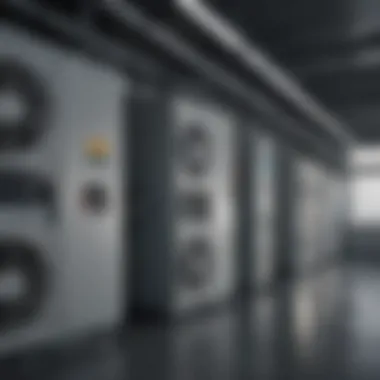Exploring Room Heat and Air Units: A Comprehensive Overview


Intro
Understanding room heat and air units is crucial for many industries, particularly for agriculture farmers and related enthusiasts. These units, essential for regulating climate in various spaces, hold significant importance in optimizing production and maintaining comfort. With technologies continually evolving, staying informed about these units can lead to better decisions and greater efficiency.
Key Concepts and Terminology
Understanding the fundamental terms related to heat and air units is essential for grasping their functionalities.
Definition of Terms
- HVAC: An acronym for Heating, Ventilation, and Air Conditioning, which describes the systems used for interior environmental comfort.
- Thermal Comfort: Refers to the satisfaction of humans within their immediate environment concerning temperature.
- Indoor Air Quality (IAQ): This term refers to the air quality within and around buildings and structures, particularly as it relates to the health and comfort of the occupants.
- Energy Efficiency Ratio (EER): This measures the efficiency of cooling and heating units. It is important for understanding energy consumption and potential cost savings.
Overview of Relevant Practices
A comprehensive understanding of HVAC practices can enhance effectiveness and efficiency in various applications.
- Regular Maintenance: Essential for efficiency. It prolongs life and minimizes energy waste.
- Proper Installation: Incorrect installation can lead to inefficiencies. It is necessary to follow manufacturer instructions closely.
- Ventilation: Proper airflow is vital for maintaining indoor air quality, affecting both health and comfort.
Current Trends and Innovations
The landscape of room heat and air units is rapidly changing. Staying up-to-date with current trends enhances understanding and implementation.
Latest Research and Developments
Research focuses on energy-efficient technologies and materials. This includes the development of smart thermostats and energy recovery ventilators.
- Smart Technology: Devices like the Nest Learning Thermostat can learn user behaviors, adjusting temperatures to enhance efficiency.
- Alternative Energy Sources: Solar panels, for instance, are increasingly incorporated into HVAC systems, reducing reliance on fossil fuels.
Emerging Technologies and Tools
Technologies such as IoT (Internet of Things) enable greater control over heating and cooling systems. This can lead to optimized energy consumption. Healthier indoor environments are achievable through these innovations, indicating significant advancements in this field.
Practical Applications
Understanding the practicalities of these systems aids users in making informed decisions concerning installation, maintenance, and troubleshooting.
Step-by-Step Guides
- Installation of a Room Air Conditioner:
- Measure the space to select the right unit size.
- Check electrical requirements.
- Install the mounting bracket, attach the unit, and seal gaps.
Troubleshooting Common Issues
- If the unit is not cooling: check the filters. Dirty filters can restrict airflow, reducing efficiency.
- For unusual noises: inspect for loose parts. Tightening them can often solve the problem.
"Regular maintenance of HVAC units is not just a good practice; it's essential for ensuring optimal performance and longevity."
Understanding Room Heat and Air Units
Room heat and air units serve essential roles in modern climate control. They fundamentally impact indoor comfort, influencing both health and productivity levels. Understanding these units enables consumers and professionals alike to make informed choices, ensuring the optimal environments necessary for various activities.
Definition and Purpose
Room heat and air units provide the ability to maintain comfortable temperatures and humidity levels in indoor spaces. These units decentralize heating and cooling, allowing more precise climate control in specific areas of a building. The aim is to create environments that promote well-being while managing energy consumption effectively.
Types of Units
Room heat and air units come in several varieties, each designed to suit particular needs and preferences.
Central Heating and Air Conditioning
Central heating and air conditioning systems involve a comprehensive network that distributes heated or cooled air throughout a building. This system is characterized by its efficiency in serving larger areas. Central units convert energy into thermal energy, aiming for a balanced distribution. One key benefit is their ability to regulate temperature in multiple spaces simultaneously. However, installation can be costly, and maintenance requires regular attention to performance.
Mini-Split Systems


Mini-split systems are a versatile form of climate control, allowing for zoned heating and cooling. These units come with an outdoor compressor and one or more indoor air handlers. One defining feature is that they do not require ductwork, making them easier to install in existing structures. Their ability to provide individualized comfort in different rooms is a significant advantage. They can also be more energy efficient compared to traditional systems, but up-front costs and occasional maintenance can be notable considerations.
Window Units
Window units are compact air conditioning systems that fit within a window frame. They are a practical solution for smaller rooms or apartments. Their primary characteristic is simplicity; they are easy to install without extensive modifications. Additionally, window units are often more affordable than split systems or central air. However, they can obstruct windows and might not offer sufficient cooling for larger areas, limiting their application.
Portable Units
Portable air conditioning units provide flexibility and convenience. These units can be easily moved from room to room, offering temporary climate control where necessary. A key aspect of portable units is their relative affordability and ease of use. The drawback is that they generally do not provide the same cooling efficiency as larger, fixed installations, making them suitable for short-term solutions rather than permanent setups.
Mechanisms of Operation
Understanding the mechanisms of operation for room heat and air units is essential in comprehending how these systems maintain thermal comfort. These mechanisms involve heat exchange processes and cooling technologies, which vary based on the type of unit. Effective operation ensures that indoor environments are both comfortable and energy-efficient.
Heat Exchange Processes
Heat exchange is a fundamental aspect of how heating and cooling systems function. It involves transferring heat from one medium to another. In heating units, this often means extracting heat from outside sources or generating it internally. Conversely, in cooling systems, heat is expelled from indoor air to lower the temperature.
Key methods include:
- Conduction: Heat transfer through solid materials.
- Convection: Movement of heat through fluids like air or water.
- Radiation: Transfer of energy through electromagnetic waves.
The efficiency of these processes can greatly influence energy consumption. More efficient systems result in lower utility bills and reduced environmental impact.
Cooling Technologies
Two prominent technologies commonly found in cooling systems are vapor compression and evaporative cooling. Understanding these methods allows consumers and professionals to make informed decisions about which system best suits their needs.
Vapor Compression
Vapor compression is the most widely used method in air conditioning systems. It operates on the principle of phase changes in refrigerants. This cycle consists of four main stages: compression, condensation, expansion, and evaporation.
Key Characteristic:
- The primary feature of vapor compression is its ability to provide substantial cooling power with relatively compact design.
Vapor compression systems are highly effective and serve a wide range of applications. Their popularity stems from their:
- High efficiency under various conditions
- Ability to handle larger spaces
- Reliability and established technology
However, there are some disadvantages. For example, they rely on electricity, which can lead to higher operational costs during peak demand times. Additionally, refrigerants used may have environmental implications, compelling a shift toward more sustainable options.
Evaporative Cooling
Evaporative cooling, also known as swamp cooling, is another technology utilized primarily in dry climates. It relies on the evaporation of water to cool the air, effectively lowering temperatures without consuming excessive energy.
Key Characteristic:
- Its use of water evaporation can methodically reduce air temperature while increasing humidity levels, making it suitable for certain environments.
Evaporative cooling is known for its:
- Low energy consumption
- Minimal maintenance requirements
- Environmentally friendly operation
On the flip side, this system is less effective in humid climates, as it relies on the principle that drier air can absorb more moisture. This limitation reduces its applicability to specific geographic areas.
Energy Efficiency Considerations
Energy efficiency is a central theme in the discussion of room heat and air units. The importance lies in the dual benefits of reducing energy consumption and lowering utility bills. Efficient systems consume less energy to deliver the same level of comfort, making them not only cost-effective but also more environmentally friendly. Consumers learn the value of investing in models that have high efficiency ratings. Understanding these elements can lead to smarter purchasing decisions and long-term savings.
Understanding SEER and HSPF Ratings
SEER, which stands for Seasonal Energy Efficiency Ratio, reflects the cooling output of an air conditioning unit over a season divided by the total energy consumed in watt-hours. A higher SEER rating indicates better energy efficiency. Conversely, HSPF, or Heating Seasonal Performance Factor, measures the heating efficiency of heat pumps. Like SEER, a higher HSPF signifies greater efficiency.
To maximize comfort while minimizing energy costs, it is crucial to understand these ratings when selecting units. Higher-rated units often have better technology, which translates to less energy waste over time.


Energy Saving Practices
Regular Maintenance
Regular maintenance is a significant aspect of keeping room heat and air units running efficiently. Routine tasks like filter replacement and coil cleaning are vital. These actions ensure that the units operate at optimum performance levels. This practice is beneficial because ignored units can lead to increased energy consumption and diminished air quality.
Improper maintenance leads directly to decreased efficiency. Units working under suboptimal conditions need more energy, hence increasing costs. In this way, regular maintenance serves as both an operational necessity and a cost-saving strategy.
Smart Thermostats
Smart thermostats represent an innovative approach to temperature management. They learn user habits to optimize heating and cooling schedules. This technology allows for effective energy savings, as units can be programmed to operate only when spaces are occupied. Such units are economical and popular choices in today’s energy-conscious market.
However, while offering numerous benefits like remote access and energy tracking, smart thermostats require an initial investment. This feature must be weighed against potential energy savings to determine cost-effectiveness over time.
Zoning Systems
Zoning systems allow for personalized climate control in different areas of a building. By dividing spaces into zones with separate temperature controls, these systems reduce energy waste. They are particularly advantageous in larger homes or buildings where temperatures can vary significantly from room to room.
The flexibility of zoning systems can lead to substantial savings on energy bills, as they prevent over-conditioning in less-used areas. However, the complexity of installation may deter some users, as it requires a more intensive setup compared to conventional single-zone systems.
Installation and Setup
Installation and setup of room heat and air units are critical phases that significantly influence their efficiency and performance. Choosing the right installation method ensures that the unit operates effectively, leading to optimum comfort and energy savings. In this section, we address the essential elements of installation, including planning, selecting the appropriate unit based on room size and climate considerations, and the pros and cons of professional versus DIY installation.
Planning for Installation
Planning for the installation of a heating or air conditioning unit is the first step towards achieving a comfortable indoor environment. This process involves assessing the available space, determining the right type of unit, and understanding the power and energy requirements. Planning also includes familiarizing oneself with local building codes and regulations that may affect installation.
A well-executed plan can minimize complications during the installation process. An important aspect is to assess return air access, ensuring it allows sufficient air circulation. Considering the orientation of your building can also affect the unit's performance, as rooms that receive direct sunlight may require different equipment than those with less light. Proper planning can lead to more efficient installations, ultimately saving both time and money in the long run.
Choosing the Right Unit
Selecting the right unit varies depending on the characteristics of the space involved. Factors like room size and climate must be considered to optimize performance and energy efficiency.
Room Size Considerations
Room size is a key factor when choosing a heating or cooling unit. It affects the capacity required for maintaining a desired temperature. The total space area dictates how much heat or cool air is needed to achieve comfort. Smaller rooms may not require high-capacity units, while larger spaces might need more powerful systems.
- Key Characteristic: The ability to perform load calculations ensures that the selected unit meets the specific demands of the room.
- Benefits: This consideration is popular due to its direct impact on energy efficiency. Selecting a unit that is too small can lead to continuous operation while a unit that is too large can cycle on and off excessively, wasting energy.
- Unique Feature: Many manufacturers provide guidelines and calculators to facilitate this process. This can result in effective temperature control without unnecessary energy expenditure.
Climate Considerations
Climate also plays a vital role in selecting heating or cooling units. Different weather conditions require adjustments in unit capabilities. For instance, regions with extreme temperatures may require robust systems capable of handling significant fluctuations.
- Key Characteristic: Understanding the local climate helps in selecting a unit with the appropriate heating or cooling capacity.
- Benefits: This consideration is significant. For example, units in hot, humid areas often need dehumidification features, while those in cold climates require efficient heating solutions.
- Unique Feature: Some heating units like heat pumps can provide both heating and cooling functions, making them versatile choices in temperate regions, but they may struggle in extreme climates without supplemental heating.
Professional vs. DIY Installation
Deciding between professional installation and a DIY approach involves weighing several factors. Professional services offer expertise, ensuring code compliance and a risk-free installation. It can also provide warranties for the work performed.
However, DIY installation can save money and is feasible for those with technical skills. It allows for an understanding of the equipment but comes with risks of improper installation and potential safety hazards.
Summary: Each choice has merits, depending on skills, budget constraints, and specific requirements of the heating or cooling system. Understanding these factors will guide effective decision-making and enhance the performance of room heat and air units.
Maintenance and Troubleshooting
Maintenance and troubleshooting are crucial aspects of the performance and longevity of room heat and air units. Neglecting these elements can lead to inefficiencies, increased energy costs, and ultimately, system failure. Regular attention to maintenance ensures that units operate optimally, providing comfort year-round. Troubleshooting common issues quickly can help avoid further damage and costly repairs.
Routine Maintenance Tasks
Filter Replacement
The filter replacement is vital for the health of any heating or cooling system. Filters capture dust, allergens, and other particles from the air. Over time, a clogged filter can restrict airflow, reducing efficiency. Regularly changing the filter enhances the unit's performance and improves indoor air quality. A key characteristic of filter replacement is its simplicity. Homeowners can easily replace air filters without professional help. This task is therefore both accessible and cost-effective. A unique feature of regular filter replacement is its influence on energy consumption. Clean filters allow units to operate more efficiently, saving on energy bills. However, if neglected, dirty filters can lead to greater energy use, creating a disadvantage for the household overall.
Coil Cleaning


Coil cleaning is another essential maintenance task that cannot be overlooked. Both evaporator coils and condenser coils must be kept clean to ensure optimal heat exchange. Dust and debris can accumulate on these coils, impeding their ability to absorb and dissipate heat. A key characteristic of coil cleaning is the requirement for specific tools and techniques, often making it less straightforward than filter replacement. It is beneficial for preventing system breakdowns and ensuring efficient operation. Regular coil cleaning can help prolong the life of the unit but may require professional assistance. This can be seen as a disadvantage, particularly for homeowners who prefer to manage all maintenance tasks themselves.
Common Problems and Solutions
Insufficient Cooling/Heating
Insufficient cooling or heating is a common complaint among users. It may occur due to several factors, such as a malfunctioning thermostat, duct leaks, or inadequate unit sizing for the space. Identifying the root cause is essential for resolving this issue effectively. The key characteristic of insufficient operation is that it often stems from a lack of routine maintenance. Regular upkeep can prevent this problem from occurring. A unique feature in addressing insufficient heating or cooling is the necessity to assess both the unit and the surrounding environment. Correctly sized units operate much more effectively, which is an advantage in enhancing comfort and minimizing energy usage.
Noisy Operation
Noisy operation can indicate various issues within a heating or cooling system. It may stem from loose components, worn-out parts, or even dirty fans. Noisy units disrupt the tranquility of a space, making attention to this issue crucial. A key characteristic of noisy operation is that it can often be resolved with simple fixes, like tightening screws or cleaning components. However, ignoring such sounds can lead to more significant repairs down the line, which is a notable disadvantage. Understanding the source of the noise is important. Each type of sound may indicate a different problem, underscoring the importance of early detection and troubleshooting.
Impact on Indoor Air Quality
Indoor air quality plays a crucial role in the overall health and comfort of occupants. Poor air quality can lead to various issues, including respiratory problems and allergens. It is essential to understand how different heating and air units impact the air within a room. Good indoor air quality helps ensure that occupants breathe clean air, which is vital for maintaining their well-being.
In this section, we will explore key factors affecting indoor air quality, concentrating on the effects of ventilation and filtration. Adequate ventilation promotes the exchange of indoor air with outdoor air, helping to dilute and carry away pollutants. Furthermore, effective filtering and purifying technologies significantly improve air conditions by reducing airborne contaminants.
Ventilation Considerations
Ventilation is necessary for maintaining healthy indoor air. It involves introducing outdoor air into a space while expelling stale air. There are several types of ventilation strategies:
- Natural Ventilation: Utilizes windows, doors, and vents to facilitate airflow. This method can be effective but depends on outdoor conditions.
- Mechanical Ventilation: Involves using fans and blowers to circulate air. This is often more reliable and controllable compared to natural methods.
- Balanced Ventilation: Combines both intake and exhaust, maintaining air quality and pressure within a space.
Each strategy has its own advantages and disadvantages. Choosing the right approach depends on factors like building design, local climate, and occupancy levels.
Filtering and Purifying Technologies
Filtering and purifying technologies enhance indoor air quality significantly. They work in conjunction with heating and cooling units to remove harmful particles and allergens from the air. Let's explore two common technologies:
HEPA Filters
HEPA (High-Efficiency Particulate Air) filters are designed to trap a large number of very small particles. These filters can capture at least 99.97% of particles that have a size of 0.3 microns or larger, which includes pollen, dust, and smoke. The key characteristic of HEPA filters is their efficiency in filtration, making them a popular choice in many heating and air units.
The unique feature of HEPA filters is their fibrous structure, which creates a labyrinth that traps particles. One advantage is their ability to improve indoor air quality dramatically. On the downside, HEPA filters require regular replacement. Failure to maintain them effectively can lead to reduced performance in air purification.
UV Light Systems
UV light systems utilize ultraviolet light to inactivate airborne pathogens and microorganisms. The key characteristic of these systems is their ability to disinfect air as it passes through the unit. They are useful in improving indoor air quality by targeting bacteria and viruses, making them a beneficial choice.
The unique feature of UV light systems is their chemical-free approach to air purification. They provide an advantage in reducing allergens and pathogens without adding harmful substances to the air. However, their effectiveness depends on the duration of exposure and maintenance of the bulbs, which can diminish over time.
"Improving indoor air quality through appropriate ventilation and filtration strategies is essential for creating a healthy living environment."
In summary, understanding these systems' roles in maintaining indoor air quality is fundamental for creating a comfortable living space. They ensure reduced pollutants, promoting health and well-being among occupants.
Future Trends in Heating and Cooling
The future of heating and cooling systems is evolving rapidly, influenced by technological advancements and increasing environmental concerns. Exploring these trends is critical for understanding how to achieve energy efficiency, enhance indoor comfort, and promote sustainable practices. These developments will likely shape consumer choices and industry standards in the coming years.
Smart Home Integration
Smart home integration refers to the capability of heating and cooling units to connect with other smart devices and systems within a home. This trend enables users to control their climate settings through smartphones or voice-activated speakers. The significance of this integration lies in its convenience and improved energy management.
Users can program their heating and cooling systems to adjust automatically based on their daily routines. For example, systems can reduce energy consumption during hours when the home is unoccupied. Furthermore, features such as remote monitoring and alerts for maintenance issues enhance the overall user experience. As a result, households can achieve significant savings on utility bills while maintaining comfort.
Sustainable Technologies
Renewable Energy Sources
Renewable energy sources include solar panels and wind turbines, which provide an alternative to traditional energy use. These sources contribute to a sustainable approach in heating and cooling by minimizing reliance on fossil fuels. A key characteristic of renewable energy is its ability to lower greenhouse gas emissions, making it an attractive option for environmentally conscious consumers.
Renewable energy systems can efficiently power heating and cooling units, significantly reducing energy costs. However, initial installation costs can be high, which may deter some homeowners. Still, the long-term benefits, such as lower utility fees and a smaller carbon footprint, are compelling reasons to consider renewable energy options.
Heat Pumps
Heat pumps are gaining popularity as an energy-efficient solution for both heating and cooling. These systems work by transferring heat between the indoors and outdoors, making them versatile for year-round temperature control. One key feature of heat pumps is their ability to operate efficiently even in low temperatures, which distinguishes them from conventional heating methods.
The primary advantage of heat pumps is their effectiveness in reducing energy consumption. They are capable of providing up to three times more heating or cooling energy than the electrical energy they consume. However, the downside includes potential performance issues in extremely cold climates, where some models may require assistance from auxiliary heating sources. Regardless, heat pumps offer significant energy savings compared to traditional systems, making them a beneficial choice for many homeowners.
"The integration of smart technologies and renewable energy sources represents a pivotal shift in the future of heating and cooling systems, pushing towards more sustainable and consumer-friendly solutions."
By understanding these trends, individuals can make informed decisions about their heating and cooling needs. This knowledge is essential for anyone invested in improving their home’s energy efficiency and comfort.







